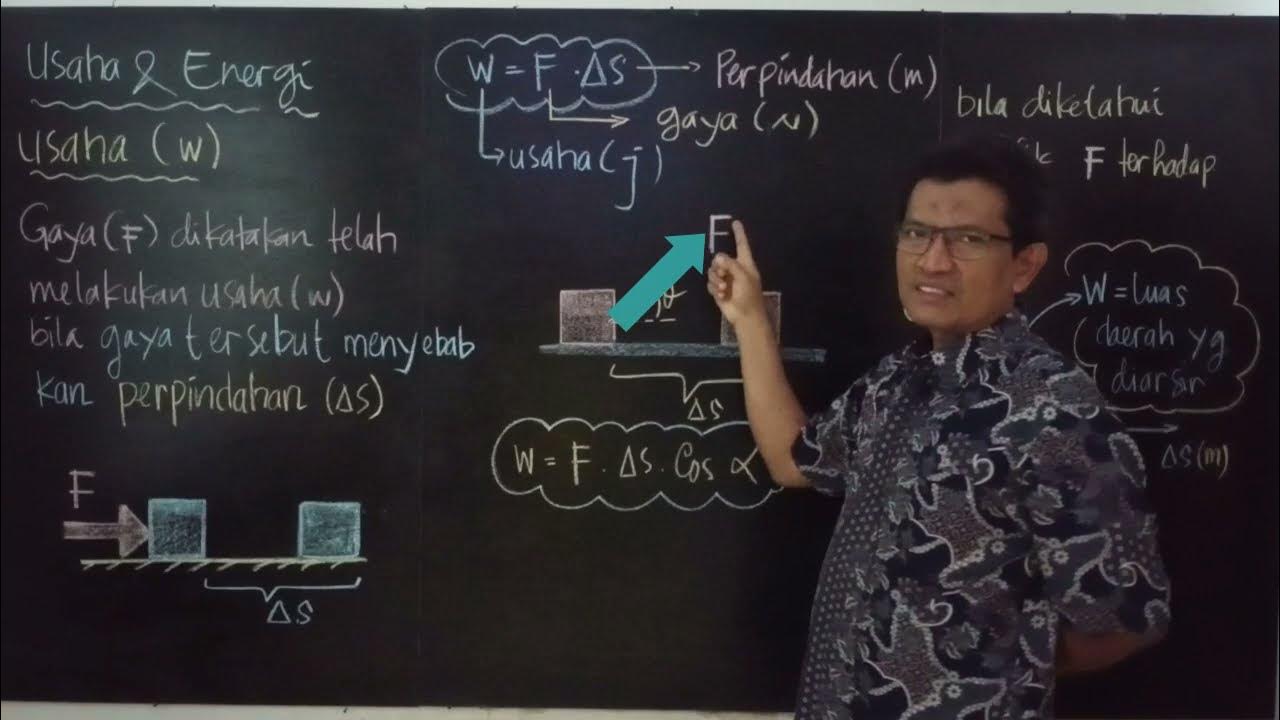WORK & ENERGY | Physics Animation
Summary
TLDRIn this video, Earth Ben introduces the concepts of work and energy in physics, explaining how work is defined as the energy transferred by a force causing displacement. He discusses how to calculate work using the formula 'Work = Force x Distance,' with practical examples such as Superman lifting an airplane and Mike pushing a car. The video also touches on the importance of distance in determining whether work is done, even when effort is applied. The work-energy theorem is briefly mentioned, with a promise of further discussion in the next video. The lesson ends with a fun trivia about work in physics.
Takeaways
- 😀 Work is defined in physics as the energy transferred by a force that causes the displacement of an object.
- 😀 Energy is the capacity to do work, and both are fundamental concepts in physics.
- 😀 Everyday activities like washing dishes, cleaning, and exercising involve work and require energy.
- 😀 The formula to calculate work is: Work = Force × Distance.
- 😀 The standard unit of work is the joule (J).
- 😀 An example of work: Superman lifting an airplane 10 meters with a force of 200 newtons, resulting in 2000 joules of work.
- 😀 If no displacement occurs, no work is done, as illustrated by Mike trying to push a car with a force but no movement.
- 😀 The amount of work done depends on both the force applied and the distance traveled by the object.
- 😀 In a second example, if Superman throws an airplane with 500 newtons of force over 5 meters, the total work done is 2500 joules.
- 😀 Trivia: Hard work in everyday life may not always mean work in physics, as demonstrated by Mike's unsuccessful attempt to move the car.
- 😀 The work-energy theorem, which relates to the change in kinetic energy, is another way to calculate work, and will be discussed in future videos.
Q & A
What is the definition of 'work' in physics?
-In physics, work is defined as the energy transferred by a force which causes the displacement of an object.
What is the definition of 'energy' in physics?
-Energy in physics is simply defined as the capacity to do work.
How is work calculated?
-Work is calculated using the formula: Work = Force × Distance.
What is the standard unit for measuring work?
-The standard unit for measuring work is the joule (J).
If Superman lifts an airplane with a force of 200 newtons for a distance of 10 meters, what is the work done?
-The work done is 200 newtons × 10 meters = 2000 joules.
Why did Mike do zero work on his dad's car even though he applied a force of 50 newtons?
-Mike did zero work because the car did not move, meaning the distance was zero. Since work involves both force and displacement, no displacement means no work was done.
How much work does Superman do if he throws an airplane with a force of 500 newtons and the airplane travels 5 meters?
-The work done is 500 newtons × 5 meters = 2500 joules.
What is the key difference between 'hard work' and 'work' in physics?
-In physics, 'work' is defined as force applied over a distance. Even if someone exerts a lot of effort, like Mike trying to push a car, no work is done if the car doesn't move.
What is the work-energy theorem?
-The work-energy theorem states that the work done on an object is equal to the change in its kinetic energy. This concept will be discussed in detail in a future video.
Why is it important to differentiate between effort and work in physics?
-It's important because in physics, work depends on displacement, not just the force applied. A person can exert effort without doing any work if there is no displacement.
Outlines

This section is available to paid users only. Please upgrade to access this part.
Upgrade NowMindmap

This section is available to paid users only. Please upgrade to access this part.
Upgrade NowKeywords

This section is available to paid users only. Please upgrade to access this part.
Upgrade NowHighlights

This section is available to paid users only. Please upgrade to access this part.
Upgrade NowTranscripts

This section is available to paid users only. Please upgrade to access this part.
Upgrade NowBrowse More Related Video

FISIKA Kelas 10 - Usaha & Energi | GIA Academy

Usaha dan Energi • Part 1: Konsep Usaha

USAHA DAN ENERGI - FISIKA - MATERI UTBK SBMPTN DAN SIMAK UI

USAHA | Usaha dan Energi #1 - Fisika Kelas 10

Work and the work-energy principle | Physics | Khan Academy

RAHASIA TERUNGKAP: Mengungkap Besaran Fisika di Balik Kincir Air yang Menggerakkan Dunia!
5.0 / 5 (0 votes)